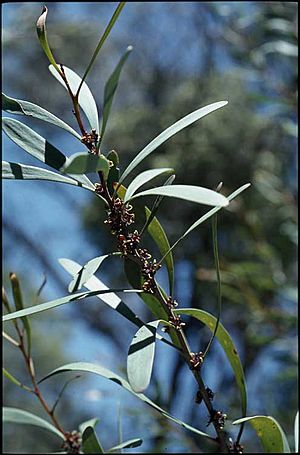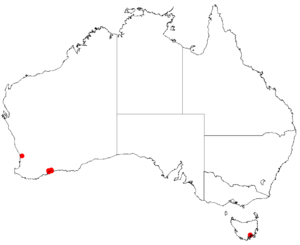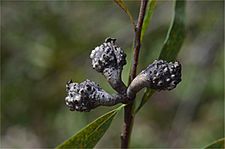Barren Range hakea facts for kids
Quick facts for kids Barren Range hakea |
|
|---|---|
 |
|
| Hakea hookeriana in the ANBG | |
| Scientific classification | |
| Genus: |
Hakea
|
| Species: |
hookeriana
|
 |
|
| Occurrence data from AVH | |
The Barren Range hakea (scientific name: Hakea hookeriana) is a special type of shrub or small tree. It belongs to the Hakea family. This plant is only found in the wild in Western Australia. People often call it the Barren Range hakea.
What it Looks Like
The Barren Range hakea grows upright. It can be a shrub or a small tree. It usually reaches a height of about 1 to 5 meters (3 to 16 feet). Its branches can be smooth or have fine hairs. They often have a reddish-brown color, like rust.
Its leaves are narrow and shaped like an oval, wider at the top. They are about 7 to 13 centimeters (3 to 5 inches) long. They are also about 10 to 25 millimeters (0.4 to 1 inch) wide.
This plant produces beautiful flowers. They can be red-brown, white, or cream-yellow. You can see them blooming from September to January. The flowers grow in groups that look like umbrellas. Each group has five, seven, or nine flowers.
After the flowers bloom, the plant forms fruits. These fruits are shaped like an oval, but a bit slanted. They are about 5 to 5.5 centimeters (2 to 2.2 inches) long. They are also about 2.7 to 3.3 centimeters (1.1 to 1.3 inches) wide. Inside the fruits are seeds. Each seed has a wing on one side, which helps it fly away.
How it Got its Name
The Barren Range hakea was first officially described in 1856. A botanist named Carl Meissner wrote about it. He included it in a large book about plants. The plant was named H. hookeriana to honor William Jackson Hooker. He was a famous botanist.
Where it Lives
You can find Hakea hookeriana in the western part of Fitzgerald River National Park. This park is located along the south coast of the Goldfields-Esperance region. This area is in Western Australia.
The plant likes to grow among rocks and on rocky cliffs. It also grows in gullies. It prefers soils made of quartzite, which is a type of rock. You will often see it growing with other plants in scrubland areas. One common plant it grows with is Banksia heliantha.


